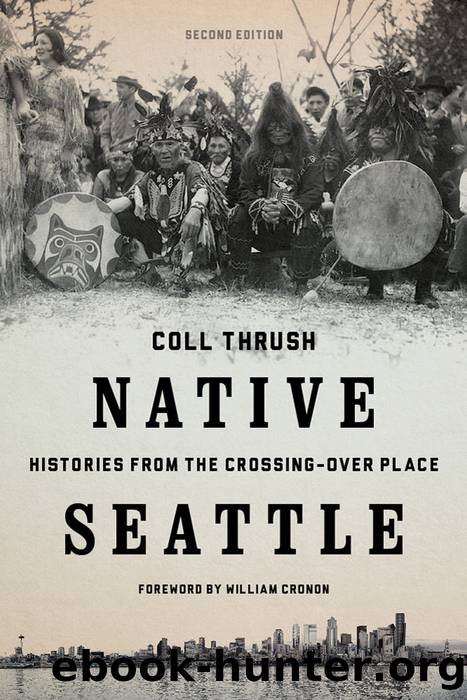Native Seattle by Coll Thrush

Author:Coll Thrush [Thrush, Coll]
Language: eng
Format: epub
ISBN: 9780295741352
Publisher: U of Washington Press
Published: 2017-09-15T05:00:00+00:00
8 / On the Cusp of Past and Future
M ARIAN WESLEY SMITH, an anthropologist at Columbia University, spent much of the 1930s conducting research among the Native peoples of Puget Sound. Her travels brought her into contact with the descendants of the indigenous people of Seattle, and the urbanized landscape of the preâSecond World War maritime Northwest shaped much of what she had to say about the state of Indians in the region. Native people on Puget Sound, Smith argued, had âcome through remarkably wellâ considering the ârigorous mushroom developmentâ of places like Seattle. âNo other Indians of the whole continent have been similarly engulfed by the sudden growth of city populations [or] have been exposed to the full impact of twentieth-century urban society,â she wrote in the 1940s. To Smith, the successful adaptation of Puget Soundâs Native peoples was âcertainly better than that of many Indians classified as less primitive.â In fact, she wrote, âit is this sort of dilemma that throws doubt upon classification schemes.â Despite the near-total dispossession of indigenous people from Seattleâs urban landscape, surviving Native peoplesâ accommodation to urban change in Puget Sound seemed to challenge her disciplineâs very foundations.1
The conditions of Indian people in urban Puget Sound also threw doubt upon another kind of classification scheme: the boundaries between past, present, and future. Smith saw this just as clearly. âIf today Salish life is mingled with, and sometimes indistinguishable from, modern American and Canadian life,â she wrote, âso much the better. If the past and the present converge, and the future may be expected to partake of both, so much closer to reality is our picture of the Northwest.â And for Indians in Seattle in the 1930s, the past, present, and future did seem to converge. Like the years surrounding 1880, the 1930s were a transition between two periods in the cityâs urban and Indian histories, a hinge between one era and another. The years around 1880 had represented a transition between a strong indigenous presence in Seattle and indigenous dispossession, as well as the beginnings of a regional Indian hinterland. By the 1930s, Seattle had developed a complex interweaving of multiple Native histories: Duwamish descendants of the areaâs indigenous communities and Native people from far away shared a city studded with totem poles and explained by stories about Indians. Mr. Gloverâs birdâs-eye panorama, the 1880 census, and other sources had offered glimpses of Native Seattle on the eve of a massive urban transformation. Sources from the 1930s show the results of that transformation and offer their own glimpses into a city that, unbeknownst to its residents (Indian or otherwise), was on the eve of yet another great change.2
In 1930, Seattle was a bona fide metropolis, a city of 350,000 people. Few vestiges of the indigenous landscape remainedâthe Duwamish River had been straightened, the waters of Lake Washington now flowed through the Hiram M. Chittenden Locks rather than the extinct Black River, and new neighborhoods of bungalows and apartments blanketed hills that had once been barriers to urban growth.
Download
This site does not store any files on its server. We only index and link to content provided by other sites. Please contact the content providers to delete copyright contents if any and email us, we'll remove relevant links or contents immediately.
Cecilia; Or, Memoirs of an Heiress — Volume 1 by Fanny Burney(32442)
Cecilia; Or, Memoirs of an Heiress — Volume 2 by Fanny Burney(31875)
Cecilia; Or, Memoirs of an Heiress — Volume 3 by Fanny Burney(31858)
The Great Music City by Andrea Baker(31548)
We're Going to Need More Wine by Gabrielle Union(18974)
All the Missing Girls by Megan Miranda(15600)
Pimp by Iceberg Slim(14400)
Bombshells: Glamour Girls of a Lifetime by Sullivan Steve(13981)
Talking to Strangers by Malcolm Gladwell(13235)
Norse Mythology by Gaiman Neil(13219)
Fifty Shades Freed by E L James(13164)
For the Love of Europe by Rick Steves(13136)
Mindhunter: Inside the FBI's Elite Serial Crime Unit by John E. Douglas & Mark Olshaker(9212)
Crazy Rich Asians by Kevin Kwan(9174)
The Lost Art of Listening by Michael P. Nichols(7412)
Enlightenment Now: The Case for Reason, Science, Humanism, and Progress by Steven Pinker(7243)
The Four Agreements by Don Miguel Ruiz(6641)
Bad Blood by John Carreyrou(6559)
Weapons of Math Destruction by Cathy O'Neil(6152)
